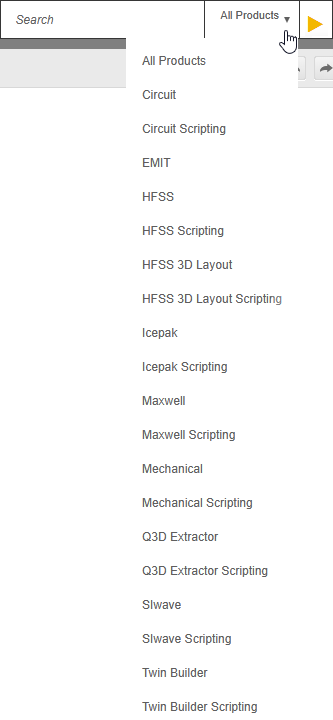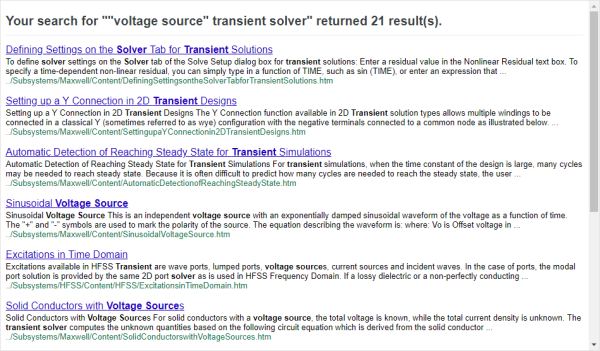Finding Information in the Online Help
The help system provides different ways to find information and navigate quickly:
- Press F1 on any open dialog box to open the relevant help topic.
- A hierarchical table of contents –
 – Browse through the table of contents, expand entries, and close entries. Click an entry to see it in the content area.
– Browse through the table of contents, expand entries, and close entries. Click an entry to see it in the content area. - A full text search – To locate occurrences of a word or phrase that may be contained in the help, use the search function.
Ansys Electronics Desktop Student includes access to PDF documentation only.
Using the Search Function in the Help
When you enter words or strings to search for in the help, the search engine lists all topics in which any of the words occur. For example, if you enter “voltage source” without the quotation marks, the results show all topics that contain “voltage” or “source.”

This method probably provides more hits than you want. The search function in the help provides several methods for making searches more specific.
Performing a Basic Search
- Type the words or string in the search box.
- If you are searching within the full Electronics help system, you see a search box that includes a drop-down filter for specifying a product, a product's scripting guide, or searching across all products. When you change the filter, the results dynamically reflect the selected filter.

- If you accessed the help for a specific product by pressing F1 in Electronics Desktop, the search box will have preselected that product. You can change the selection to a different product, a product's scripting guide, or all products.
- If you are searching within the full Electronics help system, you see a search box that includes a drop-down filter for specifying a product, a product's scripting guide, or searching across all products. When you change the filter, the results dynamically reflect the selected filter.
- Click on the topic you want in the results list.
- Some topics in different products share the same title. When searching "All Products," check the URL below each link. The URL indicates the product under which the topic falls.
- After clicking a topic, if you want to view a different topic, click your browser's back button to return to the results list.
- To turn off highlighting on the page you are viewing, click the Remove Highlights icon (
 ).
).
Searching with Quotation Marks
If you enter “voltage source” with quotation marks, the results show all topics that include the phrase.

As you can see, this returns far fewer results than the basic search.
To further limit the results, you can enter additional words, such as: “voltage source” transient solver

- Searches are not case sensitive, so you can type your search in uppercase or lowercase characters.
- You may search for any combination of letters (a-z) and numbers (0-9).
- Punctuation marks (period, colon, semicolon, comma, hyphen) are ignored during a search.
- When searching for a file name with an extension, group the entire string in quotation marks (for example, "filename.ext").
Using Boolean Operators
Functionality featured in the example(s) in this section applies to multiple design types.
You can also use boolean operators to affect the number of topics listed.
| Operator(s) | Usage | Example(s) |
|---|---|---|
|
AND + & |
Lists all topics that contain all of the terms. |
Net AND Selection Net + Selection Net & Selection |
|
OR | |
Lists all topics that contain any of the terms. |
Net OR Selection Net | Selection |
|
NEAR |
Lists all topics that contain the terms near the other terms. |
Net NEAR Selection |
|
NOT ! ^ |
Lists all topics that contain the first term but not the second. |
Net NOT Selection Net ! Selection Net ^ Selection |
Use parentheses to group terms and operators. For example:
- solver AND (Circuit) NOT HFSS NEAR dynamic
- solver AND (HFSS OR Circuit) NOT (Q3D OR 2d) NEAR dynamic
- “dynamic link” ! (HFSS | circuit)
Because the characters +, &, |, !, and ^ are used as operators, you cannot search for them in the help. Doing so will result in an error.
